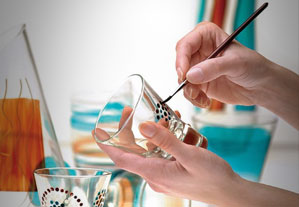
Recently I was asked to paint a design on an old window. Glass painting is something I have done in the past, however, there are new products and techniques used today that give an artist many different options. Glass is a difficult surface to prime for painting. Most mediums, in general, do not adhere well for permanency. There are, however, more and more paints that are specially formulated to be used on glass.
Pebeo makes two types of decorative glass paints, Pebeo Porcelaine 150 Ceramic Paint and Pebeo Vitrea 160 Glass Paint. They are complete systems designed to make glass painting easy and certainly enjoyable for artists of any skill level. Both types require baking to cure the paint, but the biggest difference between the two collections is that Porcelain 150 is opaque and Vitrea 160 is transparent. They can be used together and are generally used for decorating glassware such as dishes, glasses, vases, as well as Christmas ornaments. Just remember that the paint needs to be baked when dry to be completely permanent. The items painted will be dishwasher safe when the manufacturers instructions are followed exactly.
Another brand of multi-surface paint is Dr. Ph. Martin’s Metal Craft Paints collection. These paints are acrylic-based and will adhere to most surfaces including metal, glass, or plastic. It is not necessary to bake these paints for durability and they can be used outside as well. They come in a full range of colors and mediums, and are available as sets or sold individually. The paints dry to a high gloss sheen and can be a little difficult to blend, however, with patience you can achieve the look you are wanting. These can be thinned and cleaned up with water, making them very convenient to work with. They are great for outdoor signs! I even used them to paint my address on my mailbox!
Decorative Acrylics such as DecoArt Americana Acrylic Paints or Chroma’s Jo Sonja Artists’ Colors can be used to paint on glass as well. When using these it is advised to prime the area to be painted with a suitable water soluble enamel base coat. Heat setting the glass in an oven will make the paint more durable and permanent, however, in my case, this was not an option so I used several coats of varnish to protect the surface. These are probably the easiest paints to use for this project because of their smooth blending properties. Also, they are very inexpensive and come in a wonderful array of colors.
Old windows are very cost effective as well. They make a great surface to paint on and finding them can be just as fun! You can look at flea markets and thrift stores as well as keeping an eye out in your neighborhood for remodeling projects. People often kick their old windows to the curb when updating to new more efficient ones. Recycling the old windows keeps them out of the landfill and preserves a little bit of history at the same time!
Ok! On to my painting project. First, I cleaned the window with alcohol. Then, transferred the outline of my pattern to the glass using graphite paper. I painted in the design using a white enamel base coat applying 2-3 coats to cover completely. After the base coat was dry, I transferred the complete pattern on top of the base-coated area, and began painting in the design. I used artist’s acrylics to paint my design, applying several coats to complete my painting. The great thing about using acrylics on glass is that if you make a mistake you can use a razor blade to remove the undesired area and repaint it.
As for finishing the window, I chose an acrylic varnish (I used one by Golden) to protect my project. These are available in Matte, Gloss or Satin in which you can choose a spray or liquid. When you are using the spray it is necessary to mask out the unpainted glass with newspaper and tape to avoid clouding it with the varnish. I used a liquid satin varnish and applied 3 coats with a soft brush, allowing each coat to dry completely in between. It is a good idea when brushing on the varnish to overlap onto the clear glass just enough to seal the edges from any moisture.
Now the window can be displayed, either inside on a wall and when properly protected, you can enjoy the artwork outdoors such as on a porch or in a sun room. As with any art work, it is best not to display your masterpiece in direct sunlight. This may eventually fade your artwork and also cause damage to the paint itself. Finding items that are non conventional to paint on is a great way to recycle. Anything from tea cups to old picture frames can be re-purposed with a little paint and creativity, and the finished product will be greatly appreciated as gifts for friends and family as well! Just think of how much you’ll shave off your Christmas present bill! So this year use your creative talent to turn some old things into new again!






